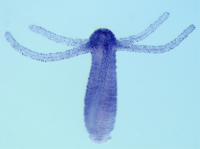
Opsin genes (blue) are present and expressed in the cnidarian Hydra. By peering deep into evolutionary history, scientists at the University of California, Santa Barbara have discovered the origins of photosensitivity in animals.
The findings are published in this week’s issue of the scientific journal PLoS ONE. The scientists studied the aquatic animal Hydra, a member of Cnidaria, which are animals that have existed for hundreds of millions of years. The authors are the first scientists to look at light-receptive genes in cnidarians, an ancient class of animals that includes corals, jellyfish, and sea anemones.
“Not only are we the first to analyze these vision genes (opsins) in these early animals, but because we don’t find them in earlier evolving animals like sponges, we can put a date on the evolution of light sensitivity in animals,” said David C. Plachetzki, first author and a graduate student at UC Santa Barbara. The research was conducted with a National Science Foundation dissertation improvement grant.
“We now have a time frame for the evolution of animal light sensitivity. We know its precursors existed roughly 600 million years ago,” said Plachetzki.
Senior author Todd H. Oakley, assistant professor of biology at UCSB, explained that there are only a handful of cases where scientists have documented the very specific mutational events that have given rise to new features during evolution.
Oakley said that anti-evolutionists often argue that mutations, which are essential for evolution, can only eliminate traits and cannot produce new features. He goes on to say, “Our paper shows that such claims are simply wrong. We show very clearly that specific mutational changes in a particular duplicated gene (opsin) allowed the new genes to interact with different proteins in new ways. Today, these different interactions underlie the genetic machinery of vision, which is different in various animal groups.”
Hydras are predators, and the authors speculate that they use light sensitivity in order to find prey. Hydra use opsin proteins all over their bodies, but they are concentrated in the mouth area, near the tip of the animal. Hydras have no eyes or light-receptive organs, but they have the genetic pathways to be able to sense light.
Source : University of California - Santa Barbara
 Print Article
Print Article Mail to a Friend
Mail to a Friend
